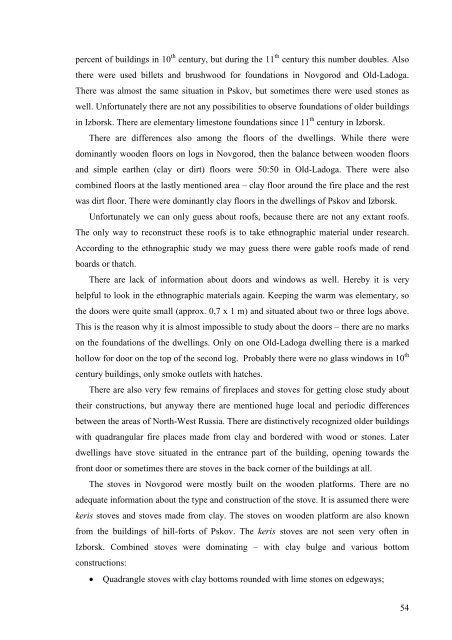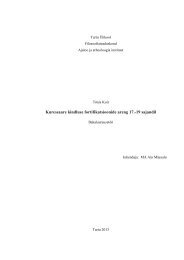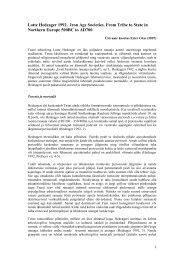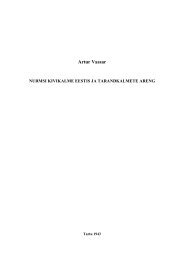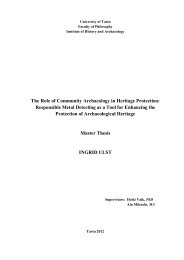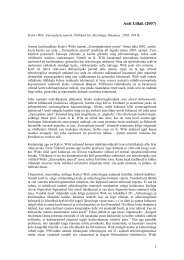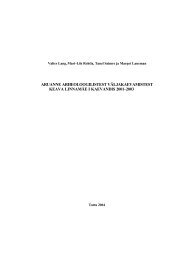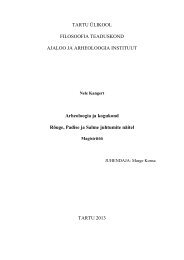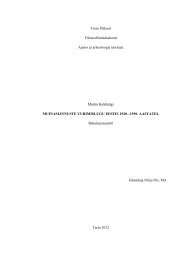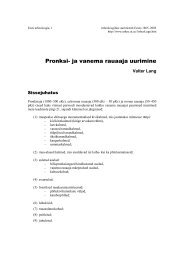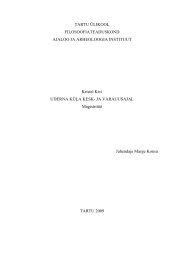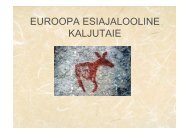eluhooned loode-venemaa linnades ja asulates 8. â 11. sajandil
eluhooned loode-venemaa linnades ja asulates 8. â 11. sajandil
eluhooned loode-venemaa linnades ja asulates 8. â 11. sajandil
Create successful ePaper yourself
Turn your PDF publications into a flip-book with our unique Google optimized e-Paper software.
percent of buildings in 10 th century, but during the 11 th century this number doubles. Alsothere were used billets and brushwood for foundations in Novgorod and Old-Ladoga.There was almost the same situation in Pskov, but sometimes there were used stones aswell. Unfortunately there are not any possibilities to observe foundations of older buildingsin Izborsk. There are elementary limestone foundations since 11 th century in Izborsk.There are differences also among the floors of the dwellings. While there weredominantly wooden floors on logs in Novgorod, then the balance between wooden floorsand simple earthen (clay or dirt) floors were 50:50 in Old-Ladoga. There were alsocombined floors at the lastly mentioned area – clay floor around the fire place and the restwas dirt floor. There were dominantly clay floors in the dwellings of Pskov and Izborsk.Unfortunately we can only guess about roofs, because there are not any extant roofs.The only way to reconstruct these roofs is to take ethnographic material under research.According to the ethnographic study we may guess there were gable roofs made of rendboards or thatch.There are lack of information about doors and windows as well. Hereby it is veryhelpful to look in the ethnographic materials again. Keeping the warm was elementary, sothe doors were quite small (approx. 0,7 x 1 m) and situated about two or three logs above.This is the reason why it is almost impossible to study about the doors – there are no markson the foundations of the dwellings. Only on one Old-Ladoga dwelling there is a markedhollow for door on the top of the second log. Probably there were no glass windows in 10 thcentury buildings, only smoke outlets with hatches.There are also very few remains of fireplaces and stoves for getting close study abouttheir constructions, but anyway there are mentioned huge local and periodic differencesbetween the areas of North-West Russia. There are distinctively recognized older buildingswith quadrangular fire places made from clay and bordered with wood or stones. Laterdwellings have stove situated in the entrance part of the building, opening towards thefront door or sometimes there are stoves in the back corner of the buildings at all.The stoves in Novgorod were mostly built on the wooden platforms. There are noadequate information about the type and construction of the stove. It is assumed there werekeris stoves and stoves made from clay. The stoves on wooden platform are also knownfrom the buildings of hill-forts of Pskov. The keris stoves are not seen very often inIzborsk. Combined stoves were dominating – with clay bulge and various bottomconstructions:• Quadrangle stoves with clay bottoms rounded with lime stones on edgeways;54


